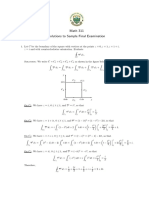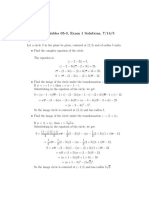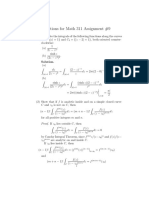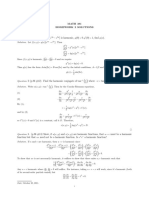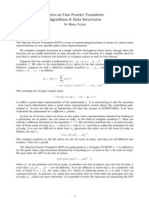S 1
Uploaded by
"The Dangerous One"S 1
Uploaded by
"The Dangerous One"UNIVERSITY OF TORONTO SCARBOROUGH Department of Computer & Mathematical Sciences MAT C34 Solution Sketch: Problem Set I
1. (Page 33; #1a;#1f) Sketch the following subsets of the complex plane a) {z C | |z 2 + i| 1} b) {z C | |z 4| |z|} 2. Find all solutions to the following equations. Write the answers in the form in the form a + ib. a) z 5 = 1 + i Soln: In polar form 1 + i = 2ei/4 . Therefore its fth roots are 21/10 ei/20 = 21/10 cos(/20) + i21/10 sin(/20) and 21/10 ei(2+/4)/5 = 21/10 ei9/20 = 21/4 cos(9/20) + i21/4 sin(9/20) and 21/10 cos(17/20) + i21/10 sin(17/20) = 21/10 cos(7/20) + i21/10 sin(7/20) and 21/10 cos(5/4) + i21/10 sin(5/4) = 21/10 cos(/4) i21/10 sin(/4) 1/10 2 1/10 2 = 2 i2 = 22/5 i22/5 2 2 and 21/10 cos(33/20) + i21/10 sin(33/20) = 21/10 cos(13/20) i21/10 sin(13/20) b) ez = 1 + i 3
= 21/10 cos(3/20) i21/10 sin(3/20)
2 Soln: ez = (1)2 + 3 ei = 2e2/3 since = cos(1/ 3) = 2/3. Therefore z = log(2) + i(2/3 + 2n) for some n Z. c) sin z = 100 Soln.: sin(z) = (eiz eiz )/2i. Let w = eiz . w 1/w = 200i so w2 200iw + 1 = 0. w = (400i 40000 + 4)/2 = 200i 9999i = (200 3 1111)(i). Since 200+3 1111 and 2003 1111 are both positive, eiz = w = (2003 1111)e3/2 in polar form. 1
3. Let w be one of the three complex numbers having the property that w3 = 4 + 4 3i. a) Find |w| Soln: |w|6 = |w3 |2 = 16 + 48 = 64. |w| = 641/6 = 2. b) Let a = 2 Re(w). Show that a is a root of the polynomial p(z) = z 3 12z + 8. Soln: a = 2 Re(w) = w + w. a3 = (w + w)3 = w3 + 3w2 w + 3ww + w3 = w3 + w3 + 3ww(w + w) = (4 + 4 3i)(4 4 3i)322 a
Therefore iz = log(200 3 1111) + i(3/2 + 2n) for some n Z. z = (3/2 + 2n) i log(200 3 1111) for some n Z.
= 8 + 12
4. Find the real and imaginary parts of ee . c c Note: ab means a(b ) . Soln.: ee = ecos(z)+i sin(z) = ecos(z) ei sin(z) = ecos(z) cos sin(z) + i sin sin(z)
z
= ecos(z) cos sin(z) + iecos(z) sin sin(z) 5. Let = e2i/n . Show that 1 + 2 + 3 2 + . . . + n n1 = Soln.: (1+2+3 2 +. . .+n n1 )(1) = (+2 2 +3 3 +. . .+n n )(1+2+3 2 +. . .+n n1 ) 1 n 11 = n n (1 + + 2 + . . . + n1 ) = n n = n1 =n0=n 1 1 6. For each of the following functions f : C C, nd the set of all points z C at which f is dierentiable. a) f (x + iy) = 2x + ixy 2 Soln. f = u + iv where u(x, y) = 2x and v(x, y) = xy 2 . Regarded as a function from R2 R2 , we know from MATB41 that f is dierentiable everywhere, since the partial derivatives of u and v exist and are continuous thoughout R2 . Therefore f is complex dierentiable at points where the Cauchy-Riemann equations are satised. u = 2, u = 0, x y v 2 v 2 x = y , y = 2xy. Therefore need 2 = 2xy and 0 = y . The second equation requires y = 0 which contradicts the rst. Thus there are no points at which the Cauchy-Riemann equations are satised, so f is not dierentiable at any point. 2
n 1 .
b) f (z) = cos() z Soln: f (z) = cos z = cos(x iy) = cos(x) cos(iy) + sin(x) sin(iy) = cos(x) cosh(y) + i sin(x) sinh(y) f = u + iv where u(x, y) = cos(x) cosh(y) and v(x, y) = sin(x) sinh(y) Regarded as a function from R2 R2 , we know from MATB41 that f is dierentiable everywhere, since the partial derivatives of u and v exist and are continuous thoughout R2 . As above, our theorem from MAT41 tells that f is everywhere dierentiable as a function from R2 to R2 , so f is complex dierentiable at (x, y) i the Cauchy-Riemann equations are satised at (x, y). v u = sin(x) cosh(y), u = cos(x) sinh(y), x = cos(x) sinh(y), v = sin(x) cosh(y). x y y Therefore need, sin(x) cosh(y) = sin(x) cosh(y) and cos(x) sinh(y) = cos(x) sinh(y). Thus sin(x) cosh(y) = 0 and cos(x) sinh(y) = 0. Since cosh(y) is never 0, the rst equation implies that sin(x) = 0 in which case cos(x) = 0 and thus the second equation implies that sinh(y) = 0. The solutions are therefore (n, 0) for n Z. That is, the set of points at which f (z) is dierentiable is {(n, 0)nZ}. 7. Evaluate f (z) dz for the following functions f (z) and curves a) f (z) = Re z and is the curve parameterized by (t) = t + it2 , 0 t 1. Soln.:
f (z) dz =
1 0
Re(t + it2 )(t + it2 ) dt
1 0
t(1 + i2t) dt
1 0
t + i2t2 dt =
1 2
2i 3
b) f (z) = z 2 + 2z + 3 and is the (shorter) portion of the ellipse x2 + 4y 2 = 4 joining i to 2. Integral is independent of the path and equals g(2) g(i) where g(z) = z 3 /3 + z 2 + 3z. 3 3 Therefore the answer is 2 + 22 + 32 i3 i2 = 3i = 41 8i 3 3 3 c) f (z) = z 2 and is the perimeter of the square with vertices at 0, 1, 1 + i, i, traversed once in that order. Soln.
1 1 0 0
f (z) dz =
0
t dt +
0 1
(1 + it) i dt +
1 1
(t + i) dt +
1
(it)2 i dt
1 1 2 2 = +i (1 + 2it + t ) dt (t + 2it 1) dt i t2 dt 3 0 0 0 1 1 i 1 i 1 i 2i 1 = + i(1 + i + ) ( + i 1) + = + i 1 + i + 1 + = 3 3 3 3 3 3 3 3 3
You might also like
- Conway "Functions of One Complex Variable" SolutionsNo ratings yetConway "Functions of One Complex Variable" Solutions53 pages
- APPM 4360/5360 Homework Assignment #5 Solutions Spring 2019: Ǫ/m - Then, For All Z D and All N N (Ǫ) N (Ǫ ǪNo ratings yetAPPM 4360/5360 Homework Assignment #5 Solutions Spring 2019: Ǫ/m - Then, For All Z D and All N N (Ǫ) N (Ǫ Ǫ7 pages
- Complex Variables 05-3, Exam 1 Solutions, 7/14/5No ratings yetComplex Variables 05-3, Exam 1 Solutions, 7/14/510 pages
- Ma201 Mathematics Iii: Tutorial Problems Complex AnalysisNo ratings yetMa201 Mathematics Iii: Tutorial Problems Complex Analysis7 pages
- Solutions for Math 311 Final: i (π/3+i) −i (π/3+i)No ratings yetSolutions for Math 311 Final: i (π/3+i) −i (π/3+i)10 pages
- Problems For MATH-4300 Complex VariablesNo ratings yetProblems For MATH-4300 Complex Variables25 pages
- Complex - Pushti Practise Problem-0-MergedNo ratings yetComplex - Pushti Practise Problem-0-Merged11 pages
- EndTerm M-III 2022 - Solution - 231201 - 214303No ratings yetEndTerm M-III 2022 - Solution - 231201 - 2143039 pages
- Homework 3 - Solutions: Complex VariablesNo ratings yetHomework 3 - Solutions: Complex Variables2 pages
- G. E. Society'S H. P. T. Arts and R. Y. K. Science College, Nasik. T.Y.B.Sc. (Mathematics) Semester Iv MT 341: Complex Analysis Question Bank Multiple Choice QuestionsNo ratings yetG. E. Society'S H. P. T. Arts and R. Y. K. Science College, Nasik. T.Y.B.Sc. (Mathematics) Semester Iv MT 341: Complex Analysis Question Bank Multiple Choice Questions6 pages
- There Are Three Sections in This Paper Section - A, B and CNo ratings yetThere Are Three Sections in This Paper Section - A, B and C6 pages
- Pset Complex Variables 2 9 Problems, StahlNo ratings yetPset Complex Variables 2 9 Problems, Stahl10 pages
- Math 389 Fall 2011, Test 1 Solutions: University of TorontoNo ratings yetMath 389 Fall 2011, Test 1 Solutions: University of Toronto5 pages
- Solutions To Exercises of Complex Analysis: MECH 2007No ratings yetSolutions To Exercises of Complex Analysis: MECH 20077 pages
- Trigonometric Ratios to Transformations (Trigonometry) Mathematics E-Book For Public ExamsFrom EverandTrigonometric Ratios to Transformations (Trigonometry) Mathematics E-Book For Public Exams5/5 (1)
- De Moiver's Theorem (Trigonometry) Mathematics Question BankFrom EverandDe Moiver's Theorem (Trigonometry) Mathematics Question BankNo ratings yet
- Analytic Geometry: Graphic Solutions Using Matlab LanguageFrom EverandAnalytic Geometry: Graphic Solutions Using Matlab LanguageNo ratings yet
- Notes On Fast Fourier Transform Algorithms & Data StructuresNo ratings yetNotes On Fast Fourier Transform Algorithms & Data Structures11 pages
- Section 6.5 Complex Numbers in Polar Form: Demoive'S TheoremNo ratings yetSection 6.5 Complex Numbers in Polar Form: Demoive'S Theorem24 pages
- Kohler Engines MODELS K91 (4 HP) Kl6l ,& Kl81 (7 HP) (8 HP) Owners ManualNo ratings yetKohler Engines MODELS K91 (4 HP) Kl6l ,& Kl81 (7 HP) (8 HP) Owners Manual16 pages



